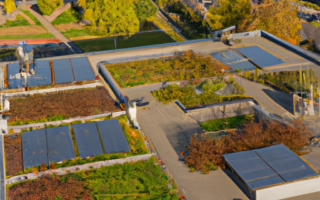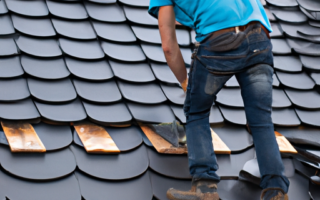Introduction to Roof Construction: Key Considerations and Planning
Introduction to Roof Construction: Key Considerations and Planning
Roof construction is a complex process that requires careful consideration and planning to ensure a sturdy and reliable structure. Whether you are building a new home or renovating an existing one, understanding the essential steps involved in roof construction is crucial for a successful project.
One of the primary considerations in roof construction is choosing the right materials. The type of roofing materials you select will depend on factors such as the climate in your area, the architectural style of your home, and your budget. Common roofing materials include asphalt shingles, metal, wood shakes, clay tiles, and slate. Each material has its own advantages and disadvantages, so it’s important to do thorough research and consult with professionals to determine the best option for your project.
Another key consideration in roof construction is the design and layout of the roof. The roof pitch, or slope, determines how steep the roof will be and affects its aesthetic appeal, as well as its functionality. The pitch of the roof also plays a role in determining the type of roofing materials that can be used. Additionally, the roof design should take into account factors such as drainage, ventilation, and insulation to ensure the longevity and energy efficiency of the structure.
Proper planning is crucial before starting any roof construction project. This involves obtaining the necessary permits and approvals from local authorities, as well as hiring a reputable contractor or construction team. It is essential to do thorough research and collect multiple quotes from contractors to ensure you are working with professionals who have the expertise and experience to complete the project to your satisfaction.
Budgeting is another important aspect of roof construction. It is crucial to set a realistic budget for the project and include all necessary expenses such as materials, labor, permits, and any additional costs that may arise. Working with a professional contractor can help you create a comprehensive budget that covers all aspects of the construction process.
Lastly, safety should always be a top priority in roof construction. This involves taking precautions such as wearing appropriate safety gear, ensuring proper fall protection equipment is in place, and following all relevant safety regulations. It is also important to consider the safety of the workers involved in the construction process and provide adequate training and supervision.
In conclusion, roof construction requires careful consideration and planning to ensure a durable and functional structure. Key considerations in roof construction include choosing the right materials, designing a suitable roof layout, proper planning and budgeting, and prioritizing safety. By focusing on these essential steps, you can ensure a successful and long-lasting roof construction project.
Understanding the Structural Components of a Roof: From Trusses to Rafters
Understanding the structural components of a roof is essential in the construction process. From trusses to rafters, each component plays a crucial role in supporting the weight of the roof and ensuring its integrity. In this comprehensive guide, we will dive into the key elements that make up a roof.
First off, let’s talk about roof trusses. Trusses are pre-fabricated frameworks made of wood or metal that provide structural support for the roof. They consist of a triangular arrangement of beams and are designed to evenly distribute the weight of the roof down to the walls of the building. Trusses are commonly used in modern roof construction due to their strength and efficiency in load-bearing.
Next, we have rafters, which are traditional structural elements used in roof construction. Rafters are inclined beams that support the weight of the roof and transfer it to the load-bearing walls. They are typically made of wood and are installed at regular intervals along the width of the roof. Rafters provide the framework for the roof and help define its shape and slope.
In addition to trusses and rafters, there are other important structural components to consider. These include ridge boards, which run along the peak of the roof and provide support for the upper ends of the rafters. Ridge boards are crucial for maintaining the stability and overall shape of the roof.
Another important component is the roof decking, which serves as the base or substrate for the roof covering. It is usually made of plywood or OSB (oriented strand board) and provides a solid surface for the installation of shingles, tiles, or other roofing materials. The roof decking also helps distribute the weight of the roof evenly across the trusses or rafters.
Lastly, we have the roof sheathing, which is a protective layer applied over the roof decking. It is typically made of plywood or OSB and provides additional strength and rigidity to the roof structure. The roof sheathing also helps to waterproof the roof and serves as a base for the final roofing material.
Understanding the structural components of a roof is crucial for any construction project. By familiarizing yourself with trusses, rafters, ridge boards, roof decking, and roof sheathing, you can ensure the stability, durability, and integrity of your roof. Whether you’re building a new roof or repairing an existing one, having a comprehensive knowledge of these components will guide you towards a successful roof construction project.
Installing Roofing Materials: Tips and Techniques for a Durable and Efficient Roof
Installing roofing materials is a crucial step in the construction of a durable and efficient roof. Choosing the right materials and applying proper techniques can greatly enhance the longevity and performance of your roof. In this comprehensive guide, we will discuss some essential tips and techniques for installing roofing materials that will help you achieve a durable and efficient roof.
The first step in installing roofing materials is to carefully select the right type of material for your roof. There are various options available, including asphalt shingles, metal roofing, clay tiles, and slate. Each material has its own advantages and considerations, such as durability, cost, and aesthetic appeal. Consider the climate, architectural style, and budget of your project when making a decision.
Once you have chosen the roofing material, it is imperative to prepare the roof surface properly. This involves removing any old roofing materials, inspecting the roof for structural issues, and repairing or replacing damaged areas. A clean and structurally sound roof surface is essential for the proper installation of new roofing materials.
To ensure a watertight and durable roof, it is important to pay attention to the installation details. Properly installing underlayment, flashing, and ventilation components can prevent leaks, improve energy efficiency, and prolong the lifespan of your roof. It is advisable to follow manufacturer instructions and industry best practices for these installation steps.
When it comes to installing the actual roofing materials, following the correct techniques is crucial. For example, when installing asphalt shingles, it is important to start from the bottom of the roof and work your way up, overlapping the shingles properly for better water resistance. Similarly, when installing metal roofing, ensuring proper fastening and seam sealing is vital for a durable and weather-resistant roof.
Another important aspect of installing roofing materials is safety. It is essential to take appropriate safety measures, such as using proper equipment, wearing protective gear, and following safety guidelines. Working on a roof can be dangerous, so it is advisable to hire professional roofers or seek guidance from experienced individuals if you are not familiar with the process.
Regular maintenance and inspections are also crucial for a long-lasting and efficient roof. It is important to periodically check for any signs of damage, such as cracked or missing shingles, and address them promptly. Timely repairs and maintenance can prevent further issues and extend the lifespan of your roof.
In conclusion, installing roofing materials requires careful planning, proper techniques, and attention to detail. By choosing the right materials, preparing the roof surface adequately, following correct installation techniques, ensuring safety, and conducting regular maintenance, you can create a durable and efficient roof that will protect your home for years to come.
Roofing Safety Measures: Ensuring a Secure and Accident-Free Construction Process
Roofing is an essential part of any construction process, and ensuring safety measures during the roofing process is of utmost importance. Construction workers involved in roof construction face various hazards that can lead to accidents or injuries if proper precautions are not taken. Implementing effective safety measures is crucial to ensure a secure and accident-free construction process.
One of the first steps in ensuring roofing safety is providing adequate training to construction workers. They should be well-versed in the use of safety equipment such as fall protection harnesses, hard hats, and non-slip footwear. Training should also cover hazard identification and risk assessment, as well as proper ladder usage and scaffold setup.
Proper planning and organization are also key factors in ensuring safety during roof construction. A detailed safety plan should be established prior to starting the project, addressing potential risks and outlining steps to mitigate them. This plan should be communicated to all workers involved and reviewed regularly to account for any changes in the construction process.
Regular inspection and maintenance of roofing equipment and machinery is another critical aspect of safety. All equipment should be routinely inspected for any signs of wear and tear and replaced or repaired as needed. This includes ladders, scaffolding, roofing materials, and power tools. Proper maintenance ensures that equipment is in good working condition, reducing the risk of accidents caused by faulty machinery.
Implementing fall protection systems is crucial to prevent falls from heights, which are a leading cause of injuries during roof construction. Guardrails, safety nets, and personal fall arrest systems should be installed in accordance with local safety regulations. Workers should be trained on their proper usage and regularly reminded about the importance of using these systems whenever working at heights.
Weather conditions also play a significant role in roofing safety. Construction should be temporarily halted in adverse weather conditions such as strong winds, heavy rain, or lightning storms. Wet surfaces can be slippery and increase the risk of falls, while lightning poses a significant danger. Monitoring weather forecasts and having a contingency plan in place can help minimize the impact of unfavorable weather on the construction process.
Lastly, promoting a culture of safety is essential for maintaining a secure construction environment. This includes encouraging workers to report potential hazards or near-miss incidents, conducting regular safety meetings, and recognizing and rewarding safe behaviors. By prioritizing safety and providing a supportive environment, accidents can be greatly reduced, ensuring a successful and accident-free roof construction process.
In conclusion, roof construction safety should never be overlooked. By implementing essential safety measures, providing proper training, and promoting a culture of safety, construction companies and workers can greatly reduce the risk of accidents and injuries. Prioritizing safety ensures not only the well-being of construction workers but also the successful completion of roofing projects.



